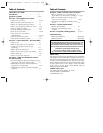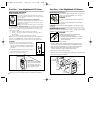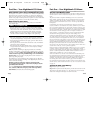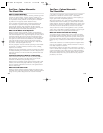
i
ii
About This User’s Guide
Notice we call this booklet a “User’s Guide” and not an “Owner’s
Manual.” This is because our intention is you use this guide just as
you will be using your Nighthawk CO alarm. Keep the guide in a
handy location and refer to it when you have questions about your
CO alarm, its functions and features, or if you have questions about
carbon monoxide. It will take about an hour of your time, but it’s well
worth it. Please read it in the sequence presented. Reading this guide
is the only way to learn how to use your CO alarm wisely and to
know how to react in the event of an alarm.
Part One
Your Nighthawk Carbon Monoxide Alarm, covers the unique
features of your Nighthawk carbon monoxide alarm, how and where
to install it, as well as information on testing and maintaining your CO
alarm.
Part Two
Carbon Monoxide - The Silent Killer, contains valuable informa-
tion about carbon monoxide (CO). From discovering the most com-
mon sources of CO in your home to recognizing the symptoms of CO
poisoning, this section provides tips and information that could help
protect your family from carbon monoxide poisoning.
Part Three
What You Should Know Before the Alarm Sounds, describes
the effects of exposure to CO levels over time and when your
Nighthawk CO alarm will alarm. It also tells you how to determine
who is at high risk for CO poisoning.
Part Four
What to do When the Unit Alarms, gives you step-by step infor-
mation on how to respond to an alarm situation. Also covered is
whom to call for help if you think you have CO in your home.
Part Five
Technical Information, covers the technical specifications of your
Nighthawk CO alarm.
Part Six
Frequently Asked Questions, contains the most commonly asked
questions about our alarms. Part six was written by KIDDE Safety
customer service representatives who handle thousands of calls per
month, year-round. This section provides you with answers and tips
that will most likely answer any questions you might have after read-
ing this user’s guide.
Introduction
This Nighthawk carbon monoxide (CO) alarm is an important part of
your family’s home safety plan. So important, the U.S. Consumer
Product Safety Commission (CPSC) recommends that every household
should have at least one carbon monoxide alarm. In fact, the CPSC
chairman has said that CO alarms are “as important to home safety as
smoke alarms.” Yet because CO alarms for the home haven’t been
available until recently, most people haven’t had much experience
using them. As a new owner of a CO alarm, there are some basic
facts you should know for your protection and convenience.
Many people think that CO alarms operate like smoke alarms. And
in some basic ways, this is true. Like smoke alarms, CO alarms con-
tinuously monitor the air in your home and sound a loud alarm to
warn you of trouble.
But, the similarities end here. The way you respond to a CO alarm
is quite different than that of a smoke alarm. That’s because a house
fire and a carbon monoxide problem are two distinctly different situa-
tions. If your smoke alarm were to alarm, you would quickly be able
to judge the level of danger you were in (if any) with your five sens-
es: you could see and smell the smoke, you could feel the heat, you
could see and even hear the fire burning. You could also readily see
if your smoke alarm were alarming in a non-emergency situation, say
if someone smoked up the kitchen with some seriously burnt toast.
Because your sense of sight, smell, hearing and touch give you so
much information, you could almost instantly judge what action to
take if you heard your smoke alarm.
But now, what about a CO alarm? Carbon monoxide (CO) is invisi-
ble, odorless, tasteless and non-irritating–completely undetectable to
your five senses. That’s why it’s so important to your safety that you
have a carbon monoxide alarm. But, how do you know what to do if
your unit alarms?
You have to learn what to do, because your five senses won’t tell
you. That’s why this user’s guide is so important. Please take the
time to read this guide from cover to cover, to familiarize yourself
with the facts about carbon monoxide, how your new alarm works,
and what to do if it alarms. Then, find a handy place to keep the
guide so it will be readily available in the future when you have a
question. You might want to write down KIDDE Safety’s toll-free cus-
tomer service number and keep it with your other important phone
numbers for the same reason.
Thank you for making Nighthawk a part of your complete home safe-
ty program. With proper installation and use, your new Nighthawk
CO alarm should provide you with years of dependable service.
810-1009 AC Digital 11/13/01 11:22 AM Page 4


















